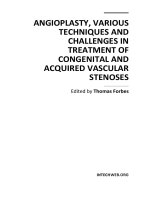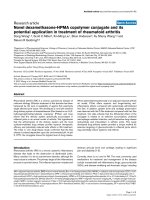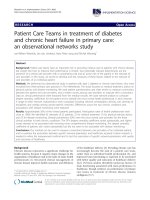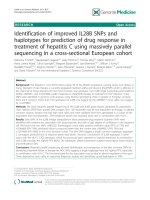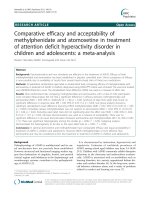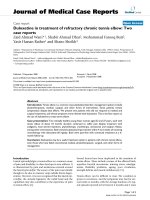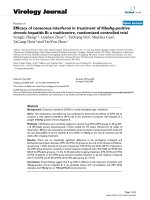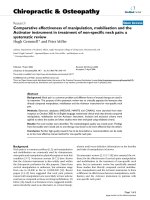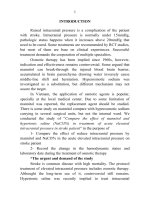adjuncts in treatment of ards
Bạn đang xem bản rút gọn của tài liệu. Xem và tải ngay bản đầy đủ của tài liệu tại đây (316.52 KB, 46 trang )
ADJUNCTS IN TREATMENT OF ARDS
Dr. AKASHDEEP SINGH
DEPARTMENT OF PULMONARY
AND CRITICAL CARE MEDICINE
PGIMER CHANDIGARH
ABJUNCTS IN TREATMENT OF ARDS
1. Ventilatory Strategies other than Lung Protective Strategy.
- Prone Ventilation
- Liquid Ventilation
- High Frequency Ventilation
- Tracheal Gas Insufflation
- Extracorporeal Gas Exchange
2. Hemodynamic Management – Fluids, Vasopressors.
3. Selective Pulmonary vasodilators.
4. Surfactant replacement therapy.
5. Anti-inflammatory Strategies.
a) Corticosteroids.
b) Cycloxygenase & lipoxygenase inhibitors.
c) Lisofylline and pentoxifylline.
6. Antioxidants – NAC : Procysteine
7. Anticoagulants.
PRONE VENTILATION
Effect on gas exchange
Improves oxygenation – allows decrease Fio
2
; PEEP
- Variable
- not predictable
response rate – 50-70%
Proposed mechanism – how it improves oxygenation
1) Increase in FRC
2) Improved ventilation of previously dependent regions.
(a) Difference in diaphragmatic movement
- supine : dorsal and ventral portion move symmetrically
- prone : dorsal > ventral
PP
L
-3.0
+2.8
P
PL
-1.0
+1.0
Supine
prone
P
PL
at dorsal Higher Less
TP pressure Lower More
Result Atelactasis opening
c) Decrease chest wall compliance in p.p
Redistribution of tidal volume to atelactatic dorsal region.
d) Weight of heart may affect ventilation.
3. Improvement in Cardiac output
4. Better clearance of secretions
5. Improved lymphatic damage
CONTRAINDICATION
- Unresponsive cerebral hypertension
- Unstable bone fractures
- Left heart failure
- Hemodynamic instability
- Active intra abdominal pathology
TIMING ARDS > 24 hrs./ 2
nd
day
FREQUENCY Usually one time per day
DURATION 2 to 20 hrs/day.
OUTCOME
Improvement in oxygenation
No improvement in survival
POSITIONING ACHIEVED BY
Circ Olectric, bed (Late 1970s).
Manual 2 step
Light weight portable support frame (Vollman prone positioner)
NO. OF PERSONS 3-5
POSITION OF ABDOMEN
allowed to protude ; partial/complete restriction
POSITION OF HEAD
Head down/ Head up position.
ADEQUATE SEDATION +/- NMBA
COMPLICATIONS
- pressure sore
- Accident removal of ET; Catheters
- Arrhythmia
- Reversible dependent odema (Face, anterior chest wall)
Gattinoni et al, in a MRCT evaluated the effect of 7 hr / day prone positioning x
10 day
improvement in oxygenation, no survival benefit
NEJM 2001, Vol 345 No 8 568-573
PARTIAL LIQUID VENTILATION
In ARDs there is increased surface tension which can be eliminated by filling the
lungs with liquid (PFC).
Perflurocarbon:
Colourless, clear, odourless, inert, high vapour pressure
Insoluble in water or lipids
MC used – perflubron (Perfluoro octy bromide) (Liquivent)
Bromide → radiopaque
ANIMAL EXPERIENCE
Improved
- Compliance - Gas exchange (dose dependent)
- lung function - Survival
Anti-inflam. properties
Decrease risk of nosocomial pneumonia.
Reduces pulm. vascular resistance.
Little effect on central hemodynamics.
Mechanism of action
i) Reduces surface tension
ii) Alveolar recruitment – liquid PEEP. Selective distribution to
dependent regions.
iii) Increases surfactant phospholipid synthesis and secretion.
iv) Anti Inflam. Properties
A. Indirect
Mitigation of VILI
B. Direct
a)decrease endotoxin stimulated release of TNF; IL-1; IL-8.
b) decrease production of reactive oxygen species.
c)Inhibit neutrophil activation and chemostaxis.
d) Lavage of cellular debris.
Technique of PFC Ventilation :
1. Total liquid ventilation
2. Partial liquid ventilation
TLV PLV
1. Ventilator Liquid Conventional
2. Tidal volume delivered of Oxygenated PFC Gas
3. Lungs are filled Completely by
PFC
Filled till FRC by
PFC
4. Feasibility Expt. Yes
5. Disadvantage Loss of gas by
evap., cost.
Recommended dose of PFC
-20 ml/kg
Beyond this dose – decrease co.
More clinical trials are req. to demonst. efficacy.
Additive effect of PLV has been shown in combination with:
- NO - Surfactant
- HFOV - prone ventilation
2 published adult trials of PLV in ARDS have confirmed its
safety
but not efficacy.
Hirschl et al JAMA 1996, 275; 383-389
Gauger et al, CCM 1996, 24; 16-24
TRACHEAL GAS INSUFFLATION (TGI)
In ARDS/ALI
1. Increase physiological dead space
2. OLS / permissive hypercapnia
DURING CONVENTIONAL VENTILATION :
Bronchi and trachea are filled with alveolar gas at end
exhalation which is forced back into the alveoli during next
inspiration.
IN TGI
Stream of fresh air (4 to 8 L/min) insufflated thr. – small cath.
or through small channel in wall of ET into lower trachea
flushing Co
2
laden gas.
COMPLIC.
1) Dissecation of secretions
2) Airway mucosal injury
3) Nidus for accumulation of secretions
4) Auto – PEEP
HIGH FREQUENCY VENTILATION
Utilizes small volume (<V
D
) and high RR (100 b/min)
Avoids over distention (Vili).
Alveolar recruitment.
Enhances gas mixing, improves V/Q.
APPLIC.
1. Neonatal RDS.
2. ARDS.
3. BPF.
COMPLIC.
1. Necrotizing trachebronchitis.
2. Shear at interface of lung.
3. Air trapping.
Two controlled studies (113 and 309) no benefit.
Carlon et al, 1983, Chest 84; 551-559
Hurst et al, 1990, Ann Surg 211; 486-91
Expiration Passive Active Passive
Potentiation of
intrinsic PEEP
3+ 2+ 1+
VT x f product for
effective V
A
>> Conv >> Conv
P
PK
< Conv < Conv
P mean
<or> conv <or> conv
JET Oscillator Conventional
Freq avail upto 600 b/min 300-3000 b/min 2-60 b/min
Tidal volume
delivered
<or> V
D
< V
D
>> V
D
Comparison of HFV Vs Conv. Ventil.
EXTRACORPOREAL MEMBRANE OXYGENATION
Adaptation of conventional cardiopulmonary bypass technique.
Oxygenate blood and remove CO
2
extracorporally.
TYPES
1. High-flow venoarterial bypass system.
2. Low-flow venovenous bypass system.
Criteria for treatment with extracorporeal gas exchange
Fast entry criteria
PaO
2
<50 mmHg for >2 h at FiO
2
1.0; PEEP > 5 cmH
2
O
Slow entry criteria
PaO
2
<50 mmHg for >12 h at FiO
2
0.6; PEEP > 5 cmH
2
O
maximal medical therapy >48 h
Q
s
/Q
t
> 30%; CTstat <30 ml/cmH
2
O
Mechanical Patient related Problem
1. Oxygenator failure Bleeding
2. Circuit disruption Neurological complications
3. Pump or heat exchanger Additional organ failure
mal functioning.
4. Cannula placement/removal Barotrauma, infection,
metabolic
Year Survival
1966 – 1975 10-15%
1980 onward 40-50%
Critical care 2000, 4; 156-168
HEMODYNAMIC MANAGEMENT
Controversial
Restriction of Fluid
Benefit
Obs. Studies Show
↓pulm. edema formation
↑ compliance, lungs fn.
Improved survival
Negative fluid balance is associated with improved survival
Humphrey et al., 1990 Chest 97 ; 1176-80.
Net positive balance <1 lt. in first 36 hrs. a/w improved survival
decrease length of ventilation, ICU stay and hospitalization.
Shorter duration of mech. venti., stay in ICU in pat. managed by fluid
restriction directed by EVLV c/w PAOP. No mortality benefit.
Mitchell JP, Am Rev. Respr. Dis. 1992; 145; 990-998.
Detrimental
Ineffective Circulatory Volume (Sepsis). Reduced co & ts
perfusion.
Goal
Correct Volume deficit
Guidelines for management of tissue hypoxia International consensus conference
(AJRCCM- 1996)
1. Promote oxygen delivery
Adequate volume CVP – 8-12 mmHg
PAOP-14-16 mmHg (Optimal co; less risk of Edema)
Crystalloids vs Colloids
Transfuse < 10 gm/dl
2. Reduce oxygen demand :
a) Sedation : Analgesia, NMBA
b) Treat Hyperpyrexia
c) Early institution of mech. vent. (shock).
No role of supraphysiol. oxygen delivery
Vasopressors
Following fluid resuscitation
Norepinephrine vs Dopamine
GOAL to achieve MAP 55 to 65 mmHg
Inotropes
Co. is low
PULMONARY VASCULAR CHANGES IN ARDS/ALI
1. Reduced pulmonary vasoconstriction in hypoxic shunt
areas, along with vasoconstriction in well ventilated areas.
2. PAH (Pulm. Vasoconst. ; Thromboembolism; Interstitial
edema)
- PAH aggravates edema by increasing inflow pressure.
- So role of pulm. vasodilators
Selective Pulmonary Vasodilators :
1. Inhaled Nitric oxide (iNo)
2. iv almitrine with/without iNo.
3. Aerosolized prostacyclins.
4. Inhibition of cyclic nucleotide phosphodiesterase.
5. Inhalation of Endothelin receptor antagonists.
1. Inhaled Nitric Oxide
How it is beneficial in ARDs
1. Improves Oxygenation
- Selective vasodilatation of vessel a/w better ventilation → (decrease
shunt)
- Improves v/q mismatch.
2. Reduction in pulmonary artery pressure
- Improves oxygen
- direct smooth muscle relaxation
- improved RV Fn.
- reduced capillary leak.
3. Inhibit platelet aggregation and neutrophil adhesion.
Selectivity of iNO
Rapid inactivation on contact with hemoglobin.
60 % of pat respond to iNo by increase in PO
2
>20%.
DOSAGE
Effect Dose
Increase PaO
2
1-2 ppm to <10 ppm
decrease PAP 10-40 ppm
Time of Response
<10 min to several hours.
Response to iNo is not static phenomenon.
Intra-individual variation in response :
- lung recruitment
- Coexistent pathology
- resolution of inflammation
Mortality Benefits – None
S/E
Minimal
1. Rebound pulm. hypertension & hypoxemia
2. Methemoglobinemia
3. Toxic NO
2
; Nitrous & Nitric Acid
Prevent by decrease – contact time & conc. of gas.
Almitrine
iv : low dose
Potentates hypoxic vasoconstriction
Decrease shunt, improved oxygenation
Has additive effect with
iNo
iNo + prone position
